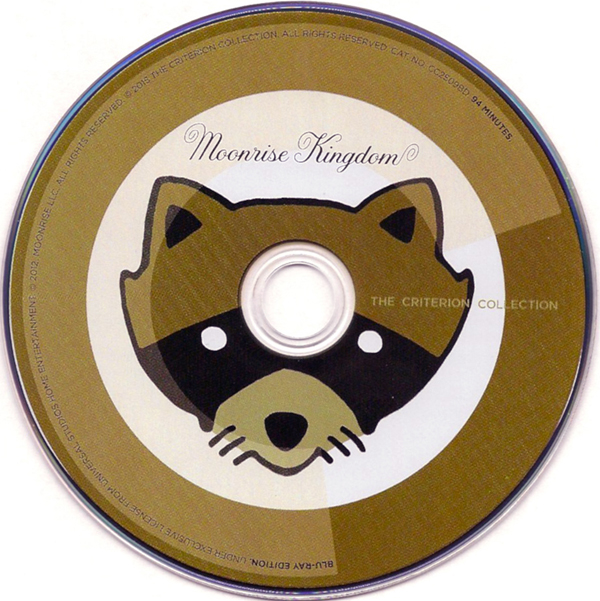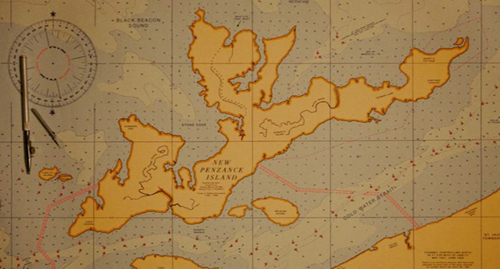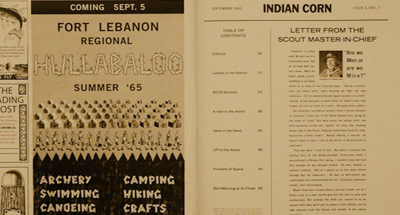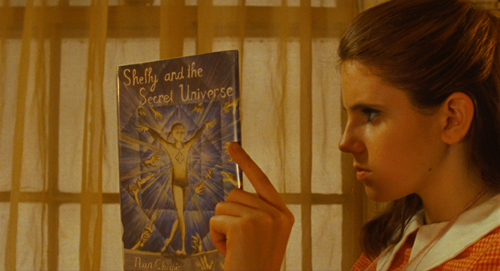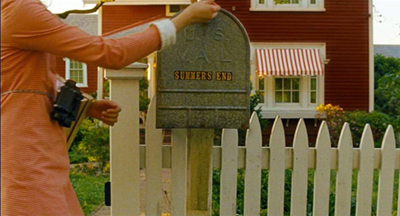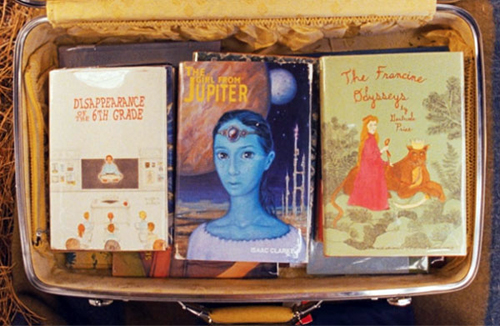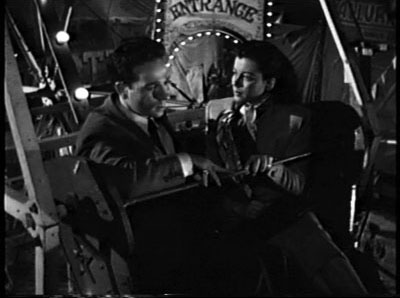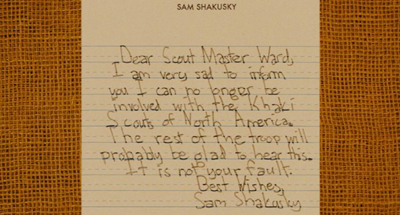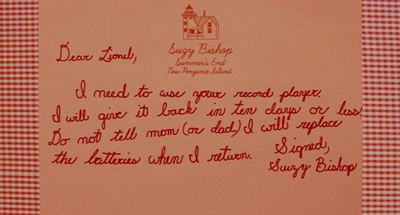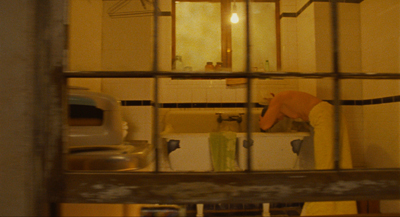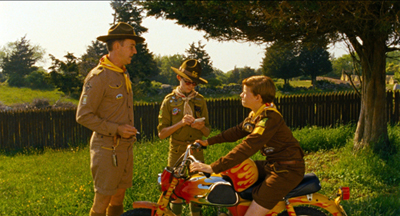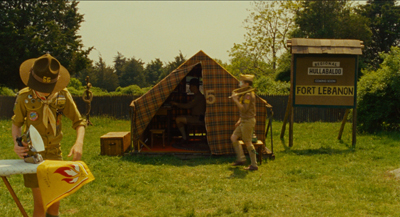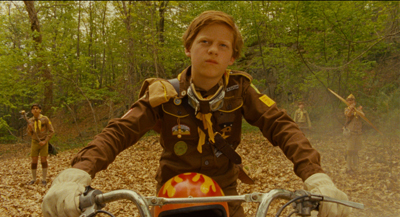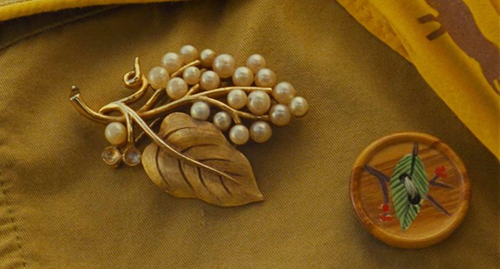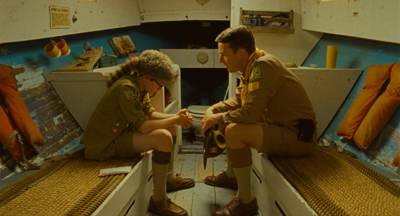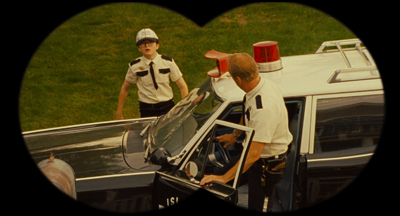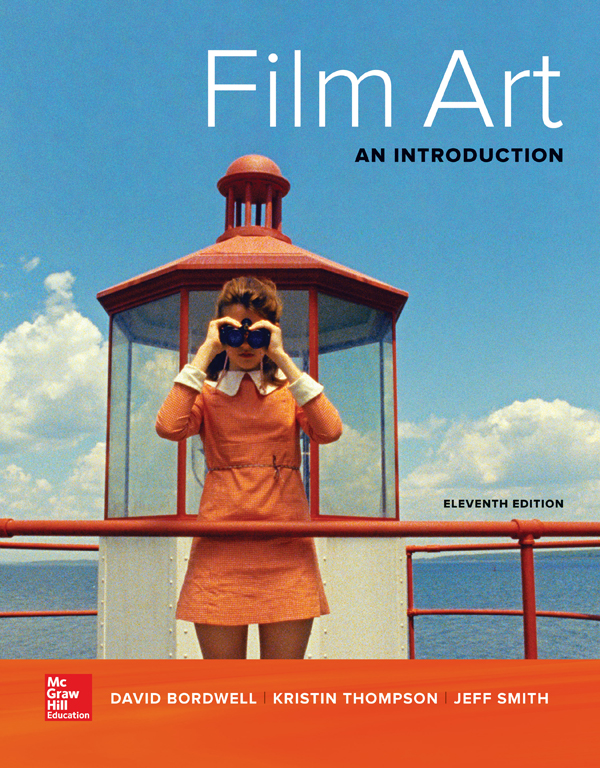DB here:
Wes Anderson is back on our blog.
I composed a 2007 entry [2] that tried to trace the stylistic tradition he belongs to (sloganized as “planimetric” staging and “compass-point editing”?). In 2014 the multiple aspect ratios of The Grand Budapest Hotel grabbed my attention [3]. That essay, revised, was included in Matt Zoller Seitz’s anthology on the film [4], duly teased and announced here [5]. At greatest length, another 2014 entry [6] offered some thoughts on Anderson’s standing as an auteur through an analysis of Moonrise Kingdom (2012).
The film has worked its way into the eleventh edition of Film Art: An Introduction, forthcoming in January. In Chapter 11 an analysis of Moonrise Kingdom joins discussions of films by Ozu, Hawks, Hitchcock, Vertov, Scorsese, and other major directors. Moonrise Kingdom, I think, a film that will have lasting interest for young viewers and filmmakers, and it’s a fine vehicle for teaching principles of narrative and style.
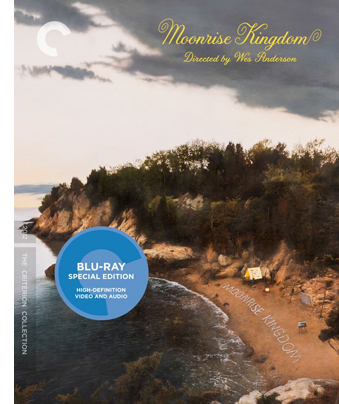 [7]Since then I’ve learned more, thought more, and seen more. Specifically, I’ve seen Moonrise Kingdom in the gorgeous new Criterion Blu-ray release [8].
[7]Since then I’ve learned more, thought more, and seen more. Specifically, I’ve seen Moonrise Kingdom in the gorgeous new Criterion Blu-ray release [8].
That release bundles in the sort of auteur artifacts my blog entry talked about. The purchaser gets a map of New Penzance, an invitation to the 1964 Noye’s Fludde performance at St. Jack’s, rather unflattering snapshots of the characters, and a postcard of the island ensemble (minus Social Services and the phone operator). On the disc we get Edward Norton home movies (as casual as anybody else’s, but showing some ingratiating behind-the-scenes stuff), some Bill Murray riffs, a brief making-of, and other snippets. The booklet, modeled on the Scouts’ magazine Indian Corn, includes a brief, sympathetic essay by Geoffrey O’Brien and reviews by kids.
A kid also conducts, if that’s the word, the extremely free-form commentary track on the disc. Young actor Jake Ryan, who plays one of Suzy Bishop’s brothers, sort of oversees chat among Anderson, Criterion leader Peter Becker, and participants in the production. Those last are brought in via phone calls. There are bathroom breaks, discussions of San Francisco Chinese restaurants, a Mozart piano performance by Jake, and a moment in which one discussant is accused, doubtless unjustly, of falling asleep. The whole enterprise, cut down from a five-hour marathon, will probably enchant Anderson devotees while giving new ammunition to those who find those admirers nuts, or worse. For my part, I found that Edward Norton and Bill Murray shared some worthwhile bits of acting craft, and Anderson gave some interesting information about the production.
Anderson adepts don’t need me to urge them toward this disc and its accessories. Today I want to think some more about this movie, which after two more viewings hasn’t lost any of its fascination for me. I’ll be concentrating on what it shows about worldmaking on the screen.
Departures, minimal and more
If you stripped off all the enticing elements like the toy lighthouse and the Khaki Scout badges, the gnomelike narrator and the interjected postcards and the implausibly perched treehouse, what do we have? In its bare bones, a pretty simple plot anatomy.
A couple in love, blocked by parental opposition, runs away. After an idyllic day and night, they are captured and separated. Then it all starts again, thanks to the miraculous conversion of some of the boy’s enemies, who decide to help him and the girl escape.
Again the couple flees, this time to be unofficially married. Pursued by parents and the authorities, the couple is trapped in a massive storm and is rescued by the kindly sheriff. They are united to live in a more-or-less tolerated love affair.
Although these are primal patterns of engagement, Moonrise Kingdom wouldn’t claim much interest if this were all it offered, folktale-fashion. As usual in modern narrative, the real interest involves finer-grained plot developments, characterizations, and narrational maneuvers. So the basic anatomy gets flesh, nerves, muscles, and circulating blood. Anderson and co-screenwriter Roman Coppola give us well-defined characters, dramatic situations, and secrets and mysteries and suspense. They play with time and viewpoint, build suspense, trigger surprises, and wrap things up with unexpected neatness. Several of these tactics I tried to chart in the 2014 entry.
Anderson and Coppola could have stopped there, but they didn’t. They went on to invent a world [10].
You can argue that this world’s main purpose is to distract us from the simple flight/pursuit/capture/rescue dynamic of the basic story action. But I’d argue that the final film benefits from fleshing the core action out in a way that situates it in a unique milieu. There’s also the point that worldmaking is no small achievement. Your task as a storyteller, George Lucas once noted, will change when you have to figure out what your character’s fork looks like.
Take the three dimensions of narrative I sketched out here [12] and here [13]—story world, plot structure, and narration. For some of us (I include myself) genre-based narrative has creative, even experimental possibilities along all those dimensions. Crime fiction, including mystery and suspense tales, can become a laboratory for experiments with plot structure and narration. Connoisseurs of thrillers and detective stories know that they must read warily, for the author is often trying to deceive and mislead. My entries on Side Effects [14] and Gone Girl [15]afford some examples of the process.
Fantasy and science-fiction can experiment with plot and narration, as do Blade Runner and Source Code [16], but those genres are more typically straightforward along those dimensions. Historically, their core appeal has relied mostly on creating unique story worlds. A prime attraction of Star Wars and The Lord of the Rings is the sense of an alternative realm teeming with unique creatures moving among unknown territories. But creating a distinctive story world puts demands on the storyteller.
We have an indefinite number of default values that are in place as we encounter any narrative. For one thing, we assume that the world we encounter there will be almost entirely like our own. Unless we’re told otherwise, we’ll assume that Sherlock Holmes can bleed.
Narrative theorist Marie Laure-Ryan calls this the principle of minimal departure. With secondary world tales, we move toward maximal departure. When a narrative world diverges drastically from ours, as those in fantasy and science-fiction do, we need a lot more extra information—about how these robots are related to their masters, about why the dragon has been sleeping for so long, about why it always seems to be raining in Blade Runner’s Los Angeles. The storyteller, in his or her own voice or via character dialogue, must spell out these minutiae.
But not all of them. Inevitably there are some unfilled spaces. Something always is left untold. As a storyteller, you know that every character comes trailing a backstory that can be expanded or revised (maybe in a sequel). In addition, your world gains solidity if you hint about tales yet to be told, as Dr. Watson alludes to the still-unwritten case of the Giant Rat of Sumatra.
What the author leaves blank others can fill in. As the internet has shown dramatically, fans can take up the job of adding to secondary worlds. They can offer their own versions of adventures in the realms of Star Trek, LotR, and other fictions. True, nothing stops you or me from writing new adventures of Sam Spade or a sequel to Rebecca, but you probably won’t be enriching the characters’ milieus with fanciful creatures or gadgets or foliage, let alone entire planets.
Several big Hollywood franchises have embraced the idea of secondary worlds, but independent cinema largely has not. Indie films tend to be modest, realist exercises that tell their stories and stop there. Part of their raison d’etre is to be different from the fantasy and science-fiction epics blasted at us by the studios. So melodramas and thrillers, biopics and anecdotal character studies, don’t by and large traffic in parallel worlds. The sequel, a standard narrative unit for worldmaking fiction, is rare in indie cinema, and even then it tends to be of a realist tenor, such as Linklater’s Before/After series. When fantasy enters an indie film, as in Being John Malkovich or Beasts of the Southern Wild, it tends to consist of one adjustment of the principle of minimal departure, not a drastic overhaul of the story world.
Now we can get a better sense of the originality of Anderson. Moonrise Kingdom, like The Life Aquatic with Steve Zissou, Fantastic Mr. Fox, and The Grand Budapest Hotel, presents itself as a richly realized parallel world. The classic comedy plot of lovers opposed by parental authority plays out in a densely furnished alternative realm derived from our own, but with its own peculiar features.
The uses of reenchantment
My 2014 blog entry [6] took this parallel-world project as a valid one and defended Moonrise Kingdom against charges of preciosity and twee. I suggested that the film had affinities with a tradition of fantasy going back to Lewis Carroll, James M. Barrie, and G. K. Chesterton. In the back of my mind I had longer-term influences as well, such as stories of Atlantis and of course Gulliver’s Travels.
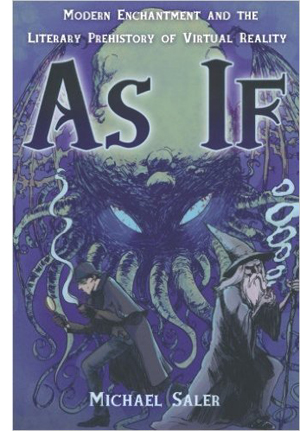 [17]Since then, I’ve read Michael Saler’s excellent 2012 book As If: Modern Enchantment and the Literary Prehistory of Virtual Reality [18]. Saler argues that the impulse toward fictional worlds in contemporary mass media and video games back to various strands of literary culture in the nineteenth century. He traces the development of a new kind of fiction: fantasy worlds rendered with the detail pioneered by emerging realist schools of writing. Poe and Verne were early sources, but the “New Romance” launched by Stevenson with Treasure Island [19] (1883) and H. Rider Haggard with She [20] (1887) crystallized the idea of imaginary lands that could be filled out in unprecedented detail. Stevenson’s and Haggard’s successors realized that maps, footnotes, news stories, eyewitness correspondence, and illustrations of artifacts could give pure fantasy a sense of solid reality.
[17]Since then, I’ve read Michael Saler’s excellent 2012 book As If: Modern Enchantment and the Literary Prehistory of Virtual Reality [18]. Saler argues that the impulse toward fictional worlds in contemporary mass media and video games back to various strands of literary culture in the nineteenth century. He traces the development of a new kind of fiction: fantasy worlds rendered with the detail pioneered by emerging realist schools of writing. Poe and Verne were early sources, but the “New Romance” launched by Stevenson with Treasure Island [19] (1883) and H. Rider Haggard with She [20] (1887) crystallized the idea of imaginary lands that could be filled out in unprecedented detail. Stevenson’s and Haggard’s successors realized that maps, footnotes, news stories, eyewitness correspondence, and illustrations of artifacts could give pure fantasy a sense of solid reality.
Admirers of these romances, Saler suggests, cultivated a complex frame of mind. They knew at bottom that it was all fiction, but they also enjoyed the imaginative freedom of a new game. They conceived a world that was as tangible as ours but still harbored the power of magic.
The imaginative exercise might vary. For extreme fans of the Sherlock Holmes saga, the task was to pretend that Arthur Conan Doyle was simply Dr. Watson’s literary agent, and that Holmes, Watson, Moriarity, and all the rest were living humans. Watson’s records of Holmes’ achievements became a sort of documentary scripture that had to be scrutinized for what it hinted at or left out. For admirers of Tolkien, engagement involved acquainting oneself with the encyclopedic variety of cultures, creatures, folklore, languages, and landscapes of a truly parallel world. What Tolkien called the legendarium presented as daunting a mythology as any discovered by a real-world ethnographer.
The broad social function of this trend, Saler argues, was to reenchant modern life. From geology to biology, from astronomy to psychology, turn-of-the-century science had blown away many dogmas. The spirit world was shrinking. The modern task of turning mysteries into puzzles for the rational intellect had begun. The “as if” invitation of virtual worlds gave both creators and consumers a way to exercise their minds in freer ways. Writers and readers could cultivate what Saler calls “animistic reason,” a rational scrutiny of what was there, but one fueled by imagination. As he notes, even that paragon of logic, Sherlock Holmes, relies on intuition and insight.
From this standpoint, Moonrise Kingdom reveals itself as part of a richer tradition than I’d realized. Its parallel world still seems to me to radiate the fairy-tale qualities of Carroll, Chesterton, and company, given some absurd twists; but now I see the emphasis on documentation, all the maps and letters and lists, as owing something to the New Romance. The film is something like a scrap-album version of a story. At the same time, the wondrous qualities of Anderson’s tale—not least, Sam’s survival of a lightning bolt and the miraculous rescue of the couple by Captain Sharp—carry, at least for me, some of that reenchanting of the everyday world that Saler finds in this tradition. Above all, we learn, as always, that things we think are very modern turn out to be new variants on something that went before. In Moonrise Kingdom, Anderson updates a nineteenth-century version of magical realism.
How to make a world
In my earlier entry I talked about how the worldbuilding enterprise fits snugly into modern cinema’s demands for both authors and brands. Anderson’s typical strategies of style and storytelling set him apart from his peers artistically, but they also offer entry points for merchandising and fan appropriation. What’s especially likable is Anderson’s embrace of the DIY aesthetic, as both he and his fans practice it. Unlike Lucas, who polices amateur Star Wars tchotchkes, Anderson encourages his admirers to spin their own riffs on his work.
Yet worldmaking is more than franchise branding. Saler’s As If, a work of cultural history, doesn’t try to analyze the literary strategies of the individual works very much. I want to ask: What does this creative option commit storytellers to? And how does Moonrise handle the challenges?
Most basically, the storyteller has to teach us the rules, big or small, that govern the world. Is it a kingdom, a post-apocalypse wasteland, or a world at war? This process goes easier if the imaginary world is a model world, a sort of schema we can fill out because it fits into a general concept we already have. If this is a kingdom, as Alice’s Wonderland partly is, then we can grasp the presence of Kings, Queens, aristocrats, soldiers, and beheadings. If it’s a wasteland, we expect something more like a world of nomadic tribes, with the absence of law producing scavenging bands and violent clashes. If an alternate world embodies one or more conceptual schemes we already know, we can learn our way around this new one faster.
The source schemas needn’t of course be absolutely real, just conceptually familiar. So the kingdom of Alice’s Wonderland is partly defined by the iconography of chess and playing cards. Likewise, our knowledge may not be wholly historical. Blade Runner’s LA is 80s Tokyo gone grubbily high-tech, but it’s also derived from the iconography of film noir. An idea of civil war informs Game of Thrones, with its borrowings from various phases of European history, but it seems likely that viewers’ familiarity with board games and role-playing games also clarify the forces in contention. The showrunner David Benioff tagged Game of Thrones “The Sopranos in Middle-Earth,” and this suggests how different schemas, real or fictional, can cooperate to distinguish a model world.
In Moonrise Kingdom, several schemas blend nicely to help us grasp the outlines and let the tweaks stand out. There’s the social situation of early adolescence, defined by family (or foster care, as in Sam’s case), schooling, and summer vacation. There’s the girl’s love of books with active heroines, a world counterposed against that of the boy scouts, with their ritualized adventures. Geographically, there’s the upper-coastal island that might be off Rhode Island, subject to tides and storms and inhabited by mostly upscale white folks. All these schemas and more are blended through the schema of “summer vacation,” a period where kids want to have adventures. Given our familiarity with these schemas, we can hook into a world of nerdish scout badges for Leaf Inspector and H2O Purifier, of slightly underscaled lighthouses, and a social worker named, by metonymy, Social Services.
An alterative world, by exaggerating a schema we already possess, can comment on the target world. Alice’s Wonderland satirizes the bloated capriciousness of the English aristocracy, and the Mad Max films suggest that increasing reliance on technology (i.e. oil-dependent machines) will paradoxically drive us backward to barbarism. In Moonrise Kingdom, probably most viewers would say that the summer in New Penzance provides a microcosm of the frustrations and disappointments of twelve-year-olds misunderstood by parents, teachers, guardians, peace officers, and other kids. By showing Sam bullied by other foster boys, as well as by the Khakis, I was reminded of my own stay in the Scouts. When the Scoutmaster’s back was turned, it all seemed merely a rehearsal for high-school thuggery.
 [23]Here’s another advantage. By mapping a schema we already know onto this new territory, we can appreciate not only the similarities but the novelties, the items that the storyteller has created to make this realm unique. In some cases, these novelties can be fairly narrowly focused. The Holmes saga emphasizes recurring characters and the furnishings and routines of the Baker Street household (keeping shag tobacco in a slipper, summoning the Irregulars). Beyond this perimeter, we are in more or less realistic 1890s London. Alternatively the infilling can be much greater, as with the imaginary landscapes and folkways of Middle-Earth. Here the creator earns esteem not only as a storyteller but as a sort of secular demiurge able, as the Romantics said, to echo the power of the Almighty. It’s easier to destroy a world than to make one.
[23]Here’s another advantage. By mapping a schema we already know onto this new territory, we can appreciate not only the similarities but the novelties, the items that the storyteller has created to make this realm unique. In some cases, these novelties can be fairly narrowly focused. The Holmes saga emphasizes recurring characters and the furnishings and routines of the Baker Street household (keeping shag tobacco in a slipper, summoning the Irregulars). Beyond this perimeter, we are in more or less realistic 1890s London. Alternatively the infilling can be much greater, as with the imaginary landscapes and folkways of Middle-Earth. Here the creator earns esteem not only as a storyteller but as a sort of secular demiurge able, as the Romantics said, to echo the power of the Almighty. It’s easier to destroy a world than to make one.
Accordingly, much of the admiration fans feel for Anderson comes from the fact that it’s idiosyncrasy all the way down, from geography and architecture to books, games, toys, indicia, and the like. Other films give us fake locations, but he interpolates fake maps and a fake guide.
The pleasure is one of unnecessary abundance that suggests new stories. The detail that isn’t dwelt on—the kitty casually carried in a fishing creel or the needlepoint landscapes that preview the film’s locations—suggest that we could turn a corner and simply find more unpredictable stuff filling this world. What’s the story about One-Eye’s bandage? Anderson talks of wanting to suggest that the Bishop attic should entice us toward other narrativess:
I also had the idea that maybe the house could have the atmosphere of a rickety old place in some book where the kids go up into the attic and reach through a broken board and find a fragment of a forgotten map and set off on an adventure—that it could have that sort of feeling.
As with Doyle’s Giant Rat of Sumatra, there would always be more to find if we could probe this world more fully. The best Almighty is one that leaves some corners of creation to be imagined.
Imaginary gardens with imaginary toads in them
The overabundance of detail is open to the charge of fussiness and self-indulgence. Isn’t packing so much in just a matter of being cute? The infilling is particularly vulnerable because it often seems merely decorative. Details that affect the story action hardly count as details any more: the Ring in The Lord of the Rings is central to the action, while the Evermind flowers [25] aren’t. Once we get beyond purely narrative functions, I think that the details of richly appointed worlds can fulfill at least five other purposes.
First, there’s realism. The doings on New Penzance and environs aren’t wholly cut off from the real world. The action is set in 1965, and the clothes, furniture, portable record player, and other furnishings match the period. To take one detail: the Françoise Hardy tune “Le temps de l’amour” anchors Suzy in a particular taste culture, that of American girls and women who took up yé-yé, Sylvie Vartan, and Salut les copains music rather than the Beatles or the Stones. American cinephiles are probably most familiar with this taste culture from Godard’s Masculin-feminin (1966).
It seems that an urge toward realism drives Anderson to build his micro-world. He speaks [26] of creating all the props: “All these things just take forever, but I feel like even if they don’t get that much time [on screen], you kind of feel whether or not they’ve got the layers of the real thing in them.” It’s striking that he uses the same word that Ridley Scott did in calling Blade Runner‘s milieu a “seven-hundred-layer cake.”
Then there’s allusion. Details that are only minimally realistic can instead point outside the film. We’re familiar with more or less public movie allusions, as when a TV playing in a bar is running a film that comments on this one. Anderson seems not to have intended the title to be an allusion in this sense, it functions as one. It brings to mind Borzage’s Moonrise (1948), a hallucinatory noir centering on a backwoods manhunt for a less-than-guilty young man and the woman who loves him.
The name of Sam’s chief Scout tormentor, Redford, is more straightforward, as is the island called Penzance, which evokes the Gilbert and Sullivan operatic fantasy of blocked romance and also comic policemen.
One task for critics is to expose to our view the more hidden allusions, like the fact that the church on St. Jack Wood Island isn’t only a play on St. John’s Wood [28] but refers to a favorite film of Anderson’s, Peter Bogdanovich’s Saint Jack (1979). Even if a viewer doesn’t know the allusion, she can suspect that any highlighted detail might like an Advent calendar window be hiding a citation.
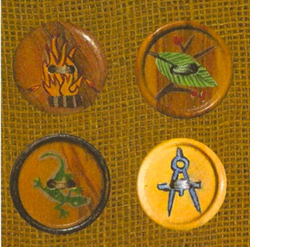 [29]The real mark of a richly realized world, as I’ve suggested, is a plethora of details that proliferate beyond the needs of realism and the temptations of allusion. So sheer density is another function. Moonrise Kingdom has to obey the principle of minimal departure, so perhaps the narrator is needed to explain the island’s geography. But in all the badges, books, and place names, the film supplies far more than the action requires. And such materials have been extended outside the film’s limits through the video extracts from Suzy’s books, the carefully printed collections of the Khaki buttons, and ephemera like those items collected in the Criterion package. Even the disc itself, with its little raccoon, is adapted to the story world. From this perspective, The Wes Anderson Collection, though a book, is exactly that: a gallery assembling items from the films’ distinct realms.
[29]The real mark of a richly realized world, as I’ve suggested, is a plethora of details that proliferate beyond the needs of realism and the temptations of allusion. So sheer density is another function. Moonrise Kingdom has to obey the principle of minimal departure, so perhaps the narrator is needed to explain the island’s geography. But in all the badges, books, and place names, the film supplies far more than the action requires. And such materials have been extended outside the film’s limits through the video extracts from Suzy’s books, the carefully printed collections of the Khaki buttons, and ephemera like those items collected in the Criterion package. Even the disc itself, with its little raccoon, is adapted to the story world. From this perspective, The Wes Anderson Collection, though a book, is exactly that: a gallery assembling items from the films’ distinct realms.
Density for its own sake is part of the worldmaking project, but it accomplishes more. The effusion of such minutiae becomes an occasion for the filmmaker to display virtuosity, a zest for creating a consistent but unpredictable wash of detritus rivaling that in our world. Prodigality of invention, even when it gets a little obsessive, can be one mark of artistic quality. Joyce, Pynchon, Zola, Balzac, and other straining appetites invite us to appreciate how they’ve stuffed a wide canvas with minutiae.
For a narrative to create a secondary world, then, we need a fair amount of sheer stuff. In Moonrise Kingdom Anderson highlights the stuff through unusual film techniques. Not content to let us simply register props in the distance or on the margins, he gives them prominence. In other films, the notes and maps and book passages that characters examine would be presented in a naturalistic way, clutched in hands or seen through optical POV. Instead Anderson simply thrusts these things at us, perfectly framed and lit, like items in a gallery display.
We shouldn’t forget a fourth function of all this detailing and infilling. Details need not point outward—toward a real world, or to other narratives, or to a New Penzance of the collective fan mind. Details can work very traditionally to bind the tale together. They can function as motifs.
My 2014 entry points out many of these, but this time I noticed the glimpse we get of Mrs. Bishop washing her hair during one of the gliding surveys of the house in the opening credits. That angling of her torso over the tub anticipates one of Sam’s drawings of Suzy we see after Mrs. Bishop finds the lovers’ correspondence.
Again, the picture isn’t in Mrs. Bishop’s hand as she shows it to the men; it’s mounted on the wall along its mates, ready for a DIY gallery show.
When I first noticed the flaming motif on the Khaki unit’s motorcycle and helmet, I thought it was associated with Redford’s petty meanness. It is, but it’s also part of the Khaki Scouts’ insignia, as we glimpse early on when a scout irons his kerchief, here in the lower left.
When Redford’s patrol attacks Sam and Suzy, Anderson cuts to one of those vitrine-display images but very abstract and flashed in alternate colors. The flash-frames conceal the action. The promise of a fight given in the symmetrical-flame logo is fulfilled, but it’s amplified by inclusion of Suzy’s weapon, the forbidding scissors. She turns the Scouts’ logo and the scissors’ brand (Lefty™) into her escutcheon.
Motifs can help the other functions. The Khaki Scouts’ branded images suggest a parallel to Boy Scouts regalia, but they also make the Penzance story world cohere as its own place. At the same time, the fiery iconography suggests the aggression that several of the boys are ready to let out at any time, and Anderson stresses that as a thematic motif through his nondiegetic inserts during the skirmish.
The fifth function, recidivism, is in a way the simplest of all. Just as we might rewatch a mystery film to see how we were misled, people can rewatch Moonrise Kingdom to seek out the sorts of felicitous touches we’ve been considering. A world saturated with details invites us to revisit it. That’s what happened with me.
Britten for boyhood
All these functions come together in one of Anderson’s most ingenious strokes, the use of the music of Benjamin Britten.
It’s an unexpected gesture of period realism from somebody of Anderson’s generation. In the 1960s classical concert music was central to intellectual culture in a way we can scarcely imagine today. Ives, Mahler, Satie, Shostakovich, and other masters were rediscovered, and avant-gardists like Varèse and Ligeti became familiar to a broad public. Imagine a time when filmmakers drew soundtracks from Penderecki (Kubrick) and Orff (Malick).
 [39]In this period, Britten achieved fame with LP recordings of his major operas, and he produced some indelible masterpieces. His War Requiem [40] (1962, recorded 1963) became a best-selling album. The Young Person’s Guide to the Orchestra, often paired with Prokofiev’s Peter and the Wolf, was recorded over a dozen times in the 1960s. The children’s pageant Noye’s Fludde (1958, recorded 1961) was designed for church performances of the sort we see in the movie (although probably few were as elaborate).
[39]In this period, Britten achieved fame with LP recordings of his major operas, and he produced some indelible masterpieces. His War Requiem [40] (1962, recorded 1963) became a best-selling album. The Young Person’s Guide to the Orchestra, often paired with Prokofiev’s Peter and the Wolf, was recorded over a dozen times in the 1960s. The children’s pageant Noye’s Fludde (1958, recorded 1961) was designed for church performances of the sort we see in the movie (although probably few were as elaborate).
The Britten details amount to allusions too, both private and public. As a boy Anderson owned The Young Person’s Guide and with his brother sang in a performance of Noye’s Fludde. Just as important, if you had to pick a classical composer of the period who was centered on youth, it would have been Britten. Not only did he write a fair amount of music for young performers, but his later work drew ideas from pieces he wrote as a boy. The film includes a portion of one of these later recastings, the Simple Symphony of 1934. Set to Anderson’s images, the music evokes the brisk innocence of Sam and Suzy. So the allusions fit the subject and theme of the movie.
What about density? According to Anderson [26], Britten’s music permeates the movie. “The movie’s sort of set to it. . . . It is the color of the movie in a way.” Britten’s music isn’t incessant, but it is vividly presented in the story world during the big scene of Noye’s Fludde. Britten pieces are excerpted throughout the score as well. At the very end, the movie goes Britten-mad, first by playing the final fugue from The Young Person’s Guide (fulfilling the tease of the opening with Suzy’s brothers) and then, in the second part of the credits, applying Britten’s dissection of parts and choirs to Alexandre Desplat’s score.
The motivic uses of the Britten details are pretty evident. The Biblical flood in the church pageant predicts the film’s climax, and like the animals rescued two by two, Sam and Suzy will be saved. Less obvious is the motivic use of a lovely melancholy song from “Friday Afternoons,” one of several Britten pieces Anderson discovered while making the film.
In “Cuckoo [41],” a boy soloist and choir sings of the cuckoo’s waning stay: he comes in spring and flies away at summer’s end. We first hear the song during the low point of Sam’s fortunes. He has just been yanked away from Suzy and, as he is ferried back to camp, he’s told by Scoutmaster Ward that his foster parents have given him up.
The song’s text and plaintive melody evoke the end of the idyll and a bleak future for Sam.
But as we’ve seen, Sam and Suzy get reunited after the second cycle of escape/ chase/ capture. The song recurs in the epilogue as Sam, touching up his landscape painting, slips out of Suzy’s house to join Captain Sharp in the driveway.
At one point Sam has nothing; at the other he has everything. Now the song seems less a lament for a final fate than something less harsh: a lyrical envoi to a charmed summer that changed Sam’s life. The ineffectual father-figure Ward is replaced by the somewhat more competent Sharp, and Sam now has a future, with his mother’s pin worn discreetly alongside his Khaki honors. The cuckoo song gently enhances a scene that is at once an end and a beginning.
As for recidivism: Well, why not rewatch the movie listening for Britten’s music?
Henry Jenkins, a pioneering scholar of “participatory culture,” once pointed out a developing trend in recent popular media. Our creators seemed to have migrated from emphasis on the story (a singular chain of events, over and done with) to the character (a protagonist like Superman who can get involved in many stories), and now to the world (a realm in which many protagonists can interact, as in the Marvel Universe). Many fans want worlds they can redesign to suit their imaginations. But maybe we should sometimes leave those worlds intact.
I’m completely happy with tales that don’t proliferate across other platforms. I like characters who don’t carry the burden of multimedia backstories. But of course I’m open to worldmaking too. I’m especially open to it when an idea so identified with corporate branding and mass-production culture gets revamped by a temperament as unpredictable as Wes Anderson’s.
I’m as pleased as anybody when a swaggering space warrior lip-syncs “Come and Get Your Love” while using an alien lizard as a hand mike in Guardians of the Galaxy. Yet I’m even more appreciative when somebody finds a way to weave yé-yé and Benjamin Britten into an enclosed world I could never have imagined, and cannot improve. In place of the big worlds of Narnia, Middle-earth, the Marvel Universe and other macrocosms, New Penzance seems the right size for shades of ironic, tender feeling. Why should I want to rewrite this world? It’s enough to discover it, and explore it.
Thanks to Kristin and Brendan Colvin for good advice.
In the small-world spirit, Criterion offers close looks at some Khaki gear [44].
What do we call these relatively self-contained realms? I’ve used several terms. Tolkien may have helped the idea coalesce by coining the label “secondary world” in his essay “On Fairy-Stories” [45]:
What really happens is that the story-maker proves a successful “sub-creator”. He makes a Secondary World which your mind can enter. Inside it, what he relates is “true”: it accords with the laws of that world. You therefore believe it, while you are, as it were, inside. The moment disbelief arises, the spell is broken; the magic, or rather art, has failed. You are then out in the Primary World again, looking at the little abortive Secondary World from outside.
Most of my information about Anderson’s creative process, including his interest in Britten, comes from Matt Zoller Seitz’s book-length interview The Wes Anderson Collection [46], particularly pp. 313-317. Anderson’s remark about the Bishop attic is on p. 300.
Marie-Laure Ryan discusses the principle of minimal departure in several publications, most fully in Chapter 3 of Possible Worlds, Artificial Intelligence, and Narrative Theory [47] (Indiana University Press, 1991). An earlier and less technical version [48] appeared in 1980.
Derek Jarman was inspired by Benjamin Britten’s music too; Jarman’s War Requiem [49] (1985) is a sort of Wagnerian music video accompanying the original recording. It’s available for streaming, rental, and purchase here [50].
See Henry Jenkins’ Convergence Culture:Where Old and New Media Collide [51] for more on popular-culture worldmaking. Henry blogs, indefatigably, at Confessions of an Aca-Fan [52].
George Lucas’s remarks about details and Ridley Scott’s about layers come from The Way Hollywood Tells It, pp. 58-60. Those pages discuss the trend toward worldmaking in mainstream Hollywood.
P. S. 5 November 2015: We have had some inquiries about whether the eleventh edition will be available for course use during the spring 2016 semester. McGraw-Hill’s intention was to introduce the new edition during the spring semester, for adoption for the fall, 2016 semester. Our editor, however, tells us that there are options for teachers who want to be early adopters and use the book in the spring.
Use of the print version for spring would be a tight squeeze unless your semester starts late in January. McGraw-Hills aims to have the SmartBook (i.e., the online ebook version) live on January 15th, the same date as the books should be on their way from the printer to the warehouse. It might take some time for books to ship once they get to the warehouse, so our editor recommends the SmartBook as the safest option for spring use. Early adoption assumes that instructors do not have lots of lecture PowerPoints and tests to update.
Usually, if the instructor works with the local MHE sales representative, the publisher can figure something out. If you are interested in being an early adopter, you should get in touch with your rep. If you don’t know who that is, you can find contact information here [53].]
